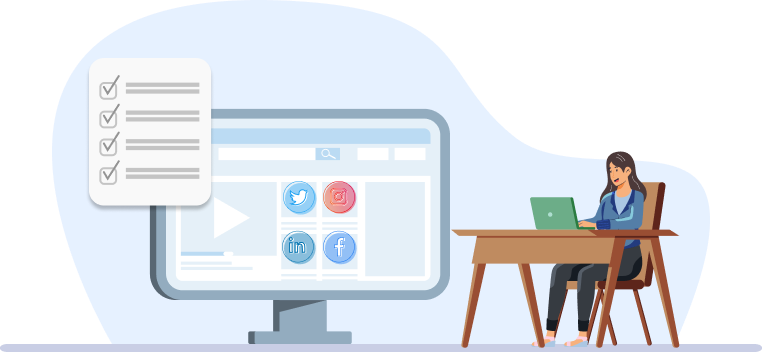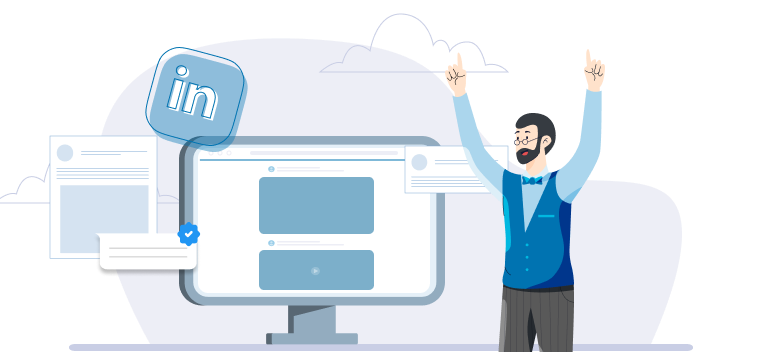Ultimate Guide to LinkedIn Social Selling Index
Social selling refers to the use of social networks to create brand awareness, engage with potential customers, and drive sales.
It typically occurs at two levels.
First, at the level of individual salespeople or influencers finding prospects and generating leads on social media platforms like Facebook, TikTok, or X. Second, at the level of brands creating content on social platforms to help with selling their products and services. At either level, social selling is a versatile strategy accessible to all individuals and businesses regardless of their size and scope.
What sets it apart from traditional selling is that instead of relying on aggressive tactics and one-way communication, social selling is a two-way street where listening and engaging take center stage. It is less about pushing products and more about building relationships as part of the sales process.
Research shows that social selling is incredibly effective. For instance, social sellers outsell their peers who don't use social media by as much as 78%. Part of that success is due to its more authentic and customer-centric approach, which today's digital consumers crave in a world saturated with ads and sales pitches.
So, how can you get started with social selling?
That's where the LinkedIn Social Selling Index (SSI) comes into play. This handy tool measures your effectiveness in leveraging social media to build your brand, nurture relationships, and drive sales.
Let’s dive into everything you need to know about the Social Selling Index —- from how it's calculated to actionable strategies for improving your score.
What Is the LinkedIn Social Selling Index?
The LinkedIn Social Selling Index (SSI) is a metric used to measure how effective you are at establishing your professional brand, finding the right people, engaging with insights, and building relationships on LinkedIn.
Think of it as your personal scorecard for social selling on LinkedIn.
The Four Key Factors of SSI
Understanding the components of your SSI score can give you a clear roadmap to becoming a social selling superstar.
Let's break down the four key factors that make up your SSI.
1. Establishing a Professional Brand
Your professional brand is the cornerstone of your social selling strategy. To establish a strong brand, ensure your LinkedIn profile is complete and reflects your expertise.
Remember to share valuable content regularly. Whether it's articles, posts, or comments, make sure your contributions reflect your knowledge and passion for your industry. Consistent sharing positions you as a thought leader and keeps you in the minds of your connections.
2. Finding the Right People
Networking isn’t just about growing your contacts list; it’s about connecting with the right people.
Use LinkedIn’s advanced search features to zero in on potential clients, decision-makers, and relevant influencers in your industry.
When sending connection requests, personalize them with a brief note explaining why you want to connect. This approach is far more effective than generic requests and lays the foundation for meaningful professional relationships.
3. Engaging With Insights
Engagement is the lifeblood of social selling. Connecting with people is not enough; you need to interact with them regularly and meaningfully.
Share and comment on industry-related content, join and participate in LinkedIn groups, and stay updated with the latest trends and discussions. By doing so, you’re keeping your network informed and positioning yourself as a knowledgeable and active participant in your field.
When you engage with insights, you demonstrate your expertise and show that you’re in tune with the latest trends and developments in your industry.
4. Building Relationships
At its core, social selling is about building and nurturing relationships. That means going beyond the initial connection and continuously engaging with your network.
Follow up with your connections by sending personalized messages, sharing content that might interest them, and offering assistance when needed.
Building strong, genuine relationships takes time, but it’s worth it. These relationships can lead to new business opportunities, partnerships, and referrals.
Why Your SSI Score Matters
Understanding the importance of your LinkedIn Social Selling Index score can help you leverage LinkedIn more effectively and achieve your social selling goals.
Here’s why it’s important:
Enhances Personal Branding
Your LinkedIn SSI score is more than just a number; it’s a reflection of your professional online presence and activity.
While others can't directly see your SSI score, the impact of a high score is evident through your increased visibility and influence on the platform.
A strong SSI score positions you as a credible and influential professional, attracting more valuable connections and opportunities as people recognize your expertise and active presence.
Increases Sales Opportunities
A high SSI score directly correlates with increased sales opportunities. A good SSI score indicates that you effectively identify and connect with the right prospects, engage them through relevant content, and nurture these relationships over time.
In fact, LinkedIn believes in the social selling score so much that it does significantly influence the platform’s algorithm. The algorithm affects your visibility of your profile and posts, which also boosts organic reach.
A high SSI score can also help you stand out among the competition, showing that you are using LinkedIn effectively as a medium to connect with potential customers. This process naturally leads to more meaningful conversations and, ultimately, more sales.
Improves Engagement and Networking
Networking is the backbone of social selling, and a high SSI score enhances your ability to connect with others effectively.
With a strong SSI score, you’re better equipped to engage with insights and participate in industry conversations. This means you’re going beyond broadcasting messages; instead, you’re listening and responding to your network's specific needs and interests.
As your connections grow and become more engaged, you gain access to a broader range of opportunities and insights. This continuous cycle of engagement and networking strengthens professional relationships.
How To Find Your LinkedIn SSI Score
Here’s a step-by-step guide to checking your SSI score:
1. Log in to Your LinkedIn Account
-
Open your web browser and navigate to the LinkedIn website.
-
Enter your username and password to log in to your LinkedIn account.
2. Go to the LinkedIn SSI Page
-
Once logged in, open a new tab in your browser
-
Enter the following URL: https://www.linkedin.com/sales/ssi
-
This will take you to the Social Selling Index page
3. View Your SSI Score
-
On the SSI page, you will see your overall SSI score displayed.
-
The maximum score is 100 points, and it is broken down into four factors:
-
-
Establishing Your Professional Brand (25 points).
-
Finding the Right People (25 points).
-
Engaging With Insights (25 points).
-
Building Relationships (25 points).
-
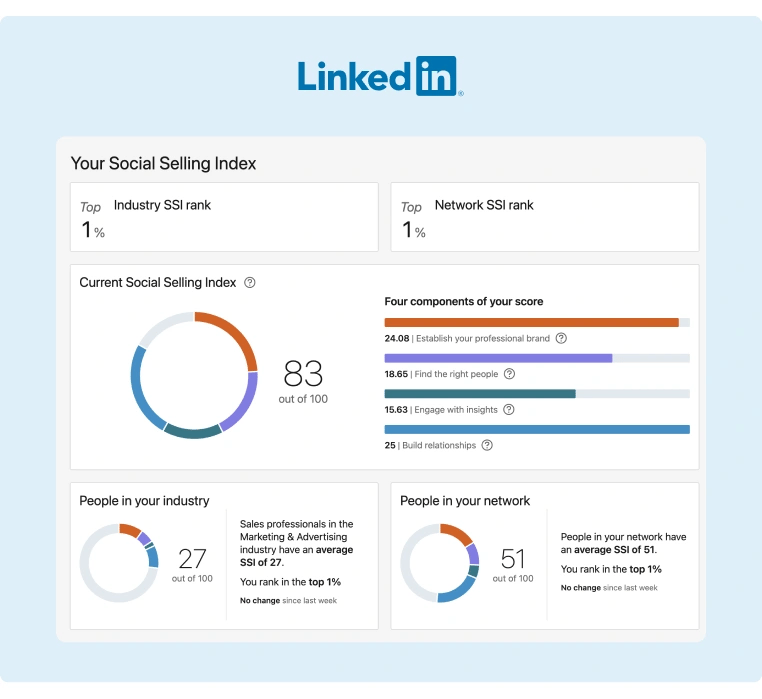
LinkedIn provides built-in analytics tools that help you monitor your SSI score over time. You can use these insights to track your progress and identify areas for improvement.
By regularly checking your SSI score and utilizing these tools, you can ensure you are on the right path to enhancing your social selling efforts on LinkedIn.
How To Improve Your Social Selling Index
According to marketing expert Neil Patel, “A good LinkedIn SSI score is 70+. Between 40 and 70 can be considered okay, while under 40 is poor.”
Want to boost your SSI score? You’ll need a strategic approach to increase your points in each of the four critical areas.
Here’s how you can do it:
Establish Your Professional Brand
It is important to create a compelling LinkedIn presence that showcases your expertise, values, and personality. Your profile must be both updated and active.
Optimize Your LinkedIn Profile
-
Professional Photo: Use a high-quality, professional headshot. A clear and approachable photo helps make a positive first impression and makes your profile more inviting.

Source: Leah Knobler
-
Compelling Headline: Craft a headline that goes beyond your job title to highlight your expertise and value proposition.
-
For instance, ‘Helping businesses thrive through innovative marketing strategies’ communicates more than just ‘Marketing Manager.’
-

Source: Erin L’Hommedieu
Erin L'Hommedieu, a technical recruiter at The Walt Disney Company, shows that LinkedIn headlines don't have to be boring. With her fun and creative tagline, "Imagine the possibilities," she brings some Disney magic to her professional profile.
It's a great reminder that you can be imaginative with your headline and still make it perfectly reflect your unique professional identity.
-
Engaging Summary: Write a summary that showcases your skills, experiences, and what drives you. Make it personal yet professional, and explain how you can add value to your network.
Highlight key achievements, your passion, and your professional goals.
Share Relevant Content Regularly
-
Industry News and Insights: Regularly post articles, blogs, and updates related to your industry. Sharing valuable content establishes you as a knowledgeable and engaged professional.
-
Personal Achievements and Experiences: Share your professional milestones, such as completing a significant project, earning a certification, or attending an industry conference. These inputs demonstrate your achievements and keep your network informed about your activities.
Find the Right People
Building a strong network is essential for social selling. While having a large number of connections can be helpful, you must also focus on finding the right people who can add value to your professional journey.
Use LinkedIn’s Advanced Search
-
Identify Prospects: Use LinkedIn’s advanced search filters to find potential clients, partners, or colleagues. Narrow your search using criteria like industry, job title, location, and company size to identify the most relevant contacts.
-
Suppose you’re looking for a professional in the finance technology field. You can type the keyword into the search bar and then use advanced filters to narrow your search based on factors such as current company, company size, and location.
-

-
Save Searches: Take advantage of LinkedIn's feature to save search criteria. This helps you keep track of promising prospects and allows for timely follow-ups.
Join LinkedIn Groups
-
Industry-Relevant Groups: Join groups that align with your industry and professional interests. These groups are valuable for networking, sharing knowledge, and staying updated with industry trends.
-
Active Participation: Engage in group discussions by commenting on posts, asking questions, and sharing your insights. Active participation increases your visibility and positions you as a thought leader in your field.
Engage With Insights
-
Curated Content: Regularly share articles, whitepapers, and reports that provide valuable information to your network. Enhance engagement by adding your thoughts or a brief summary.
-
Original Content: Write and publish your own articles or blog posts on LinkedIn. Sharing original content demonstrates your expertise and thought leadership in your field.
Comment on Posts To Start Conversations
-
Thoughtful Comments: Leave insightful comments on posts from your connections or industry influencers. Meaningful engagement can spark conversations and build relationships.
-
Ask Questions: Pose questions on your post or in your comments to encourage dialogue. Engaging others in conversation can lead to deeper interactions and stronger connections.

Source: Amber Rhodes
Build Relationships
-
Personalized Messages: When sending connection requests, always include a personalized message. Mention how you found them, why you want to connect, and what common interests or goals you share. Personalized messages increase the likelihood of acceptance and set a positive tone for future interactions.
-
Follow Up: After connecting, send a follow-up message thanking them for accepting your request. Suggest a brief call or meeting to get to know each other better and discuss potential collaboration opportunities.
Follow Up Regularly With Your Network
-
Consistent Engagement: Regularly engage with your connections by liking, commenting on, and sharing their posts. Consistent interaction keeps you on their radar and helps maintain strong relationships.
-
Check In: Periodically reach out to your connections with a simple message to check in. Whether congratulating them on a new job, asking about their latest project, or sharing a relevant article, staying in touch shows that you value the relationship.
Advanced Techniques To Boost Your SSI
Once you’ve mastered the basics of improving your SSI, it’s time to dive into advanced techniques that can further enhance your LinkedIn effectiveness.
Here are some strategies to elevate your social selling game:
Leveraging LinkedIn Tools and Features
LinkedIn offers a variety of tools and features designed to help you maximize your social selling potential. Here’s how to use them effectively:
-
LinkedIn Sales Navigator: This premium tool is specifically designed for sales professionals. It helps you find the right prospects, gain insights into your accounts and leads, and build trusted relationships.
Use Sales Navigator’s advanced search capabilities to identify potential clients and keep track of key updates.
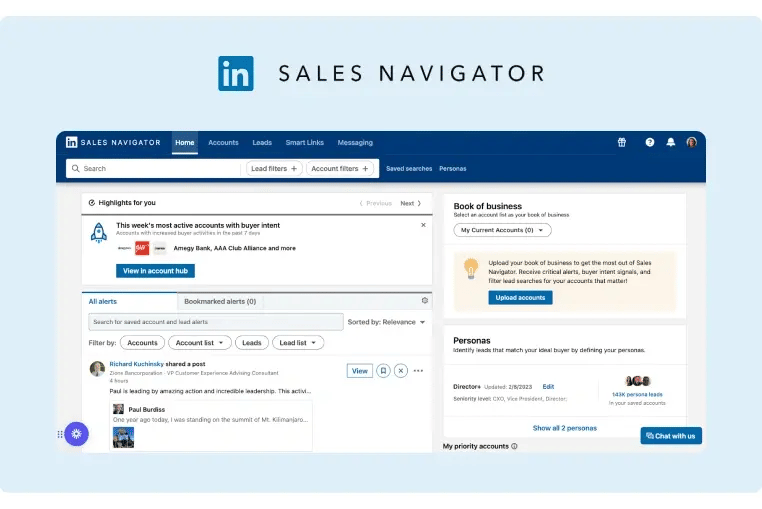
-
LinkedIn InMail: Use InMail to send personalized messages to people not in your immediate network. Crafting thoughtful and customized messages can help you connect with potential clients and influencers.
-
Content Suggestions: Use LinkedIn’s Content Suggestions feature to discover trending content in your industry. Sharing these insights can boost engagement and position you as a knowledgeable resource.
Utilizing Automation Smartly
Automation can save time and streamline your social selling efforts, but it’s crucial to use it wisely to avoid impersonal interactions:
-
Scheduling Tools: Several marketing tools allow you to schedule posts in advance. This ensures you maintain a consistent LinkedIn presence without manually posting every day.
-
Automated Follow-Ups: Use CRM tools to automate follow-up messages after connecting with new contacts. Personalize these messages to maintain a genuine touch while saving time.
-
Monitoring Engagement: Automated tools can help you monitor engagement and track who is interacting with your content. Use these insights to identify opportunities for deeper engagement.
Integrate With an Employee Advocacy Program
Employee advocacy programs like GaggleAMP can amplify your social selling efforts by leveraging the collective power of your team.
-
Amplify Content Reach: Use GaggleAMP to encourage employees to share company content on their personal LinkedIn profiles. This significantly increases your content’s reach and visibility.
-
Consistent Messaging: Ensure your brand’s messaging is consistent across all employee posts. GaggleAMP helps coordinate this by providing pre-approved content for employees to share.
-
Track Performance: GaggleAMP offers analytics to track the performance of your employee advocacy efforts. Use these insights to refine your strategy and maximize impact.
Mistakes To Avoid in Social Selling
While multiple strategies exist to enhance your Social Selling Index (SSI), it's equally important to be aware of common pitfalls that can undermine your efforts.
Avoiding the following mistakes will ensure your social selling activities are effective and genuine.
Over-Automation
Relying too heavily on automation tools can result in impersonal interactions that may turn off potential connections. For instance, using templatized messages or mass invitations without customization can make you seem like just another spammer.
Source: Kelly Vaughn
The proliferation of emojis around your name helped to separate genuine connections from spammers in the past. Today, a generic connection request like ‘Hi, I’d like to add you to my professional network on LinkedIn’ is often ignored or dismissed as spam. Instead, take a moment to personalize your message, mentioning something specific about their profile or mutual interests.
Ignoring Engagement Opportunities
Not responding to comments, messages, or interactions on your posts may signal to your network that you’re not interested in engaging. This can harm your professional image and reduce the effectiveness of your social selling efforts.
If someone comments on your post with a question or feedback and you ignore it, they may feel undervalued. Make it a point to respond promptly and engage in meaningful discussions.
Engagement opportunities such as liking, commenting, and sharing posts from your network help strengthen relationships and keep you top-of-mind.
Ignoring these can result in missed opportunities to build rapport and trust.
Not Updating Your Profile Regularly
An outdated LinkedIn profile can give the impression that you’re inactive or involved in your industry. Ensure your profile reflects your current role, skills, and achievements.
For example, having an outdated job title or not mentioning your latest project can make your profile seem stale.
Regularly updating your profile with new skills, certifications, and experiences can open up new opportunities for connections and engagements. It also ensures your profile appears in relevant searches.
Best Tools To Improve Your SSI
Improving your Social Selling Index (SSI) on LinkedIn involves using the right tools and platforms. These social selling tools help manage activities, analyze performance, and engage more effectively with your network.
Here’s an overview of some of the most helpful tools and how to use them effectively.
1. LinkedIn Sales Navigator

Designed specifically for sales professionals, LinkedIn Sales Navigator helps you find the right prospects, get insights on your accounts and leads, and build trusted relationships.
Here’s how you can make the most of it:
-
Advanced Search Filters: Use these filters to narrow down your search for highly relevant prospects by industry, company size, job title, and more.
-
Lead Recommendations: Follow LinkedIn’s lead recommendations to discover potential connections that align with your target audience.
-
CRM Integration: Sync Sales Navigator with your CRM to keep track of interactions and ensure seamless follow-up.
2. Shield Analytics

Shield Analytics provides detailed insights into your LinkedIn activities, helping you understand what works and where improvements are needed.
Here’s how to use it for maximum impact:
-
Track Engagement Metrics: Review your engagement metrics regularly to see which posts resonate most with your audience and refine your content strategy accordingly.
-
Monitor Follower Growth: Keep an eye on your follower growth to understand how your network is expanding and identify what drives the most interest.
-
Analyze Content Performance: Evaluate which types of content (articles, videos, status updates) get the most engagement and replicate successful formats.
3. Hootsuite

Hootsuite is a social media management tool that allows you to schedule and publish company posts across multiple platforms, including LinkedIn.
-
Post Scheduling: Plan your content calendar in advance and schedule posts to maintain a consistent presence on LinkedIn.
-
Content Curation: Discover and share relevant industry news and insights to position yourself as a thought leader.
-
Performance Analytics: Monitor the performance of your posts to understand what works best and adjust your strategy based on the data to improve engagement.
4. GaggleAMP
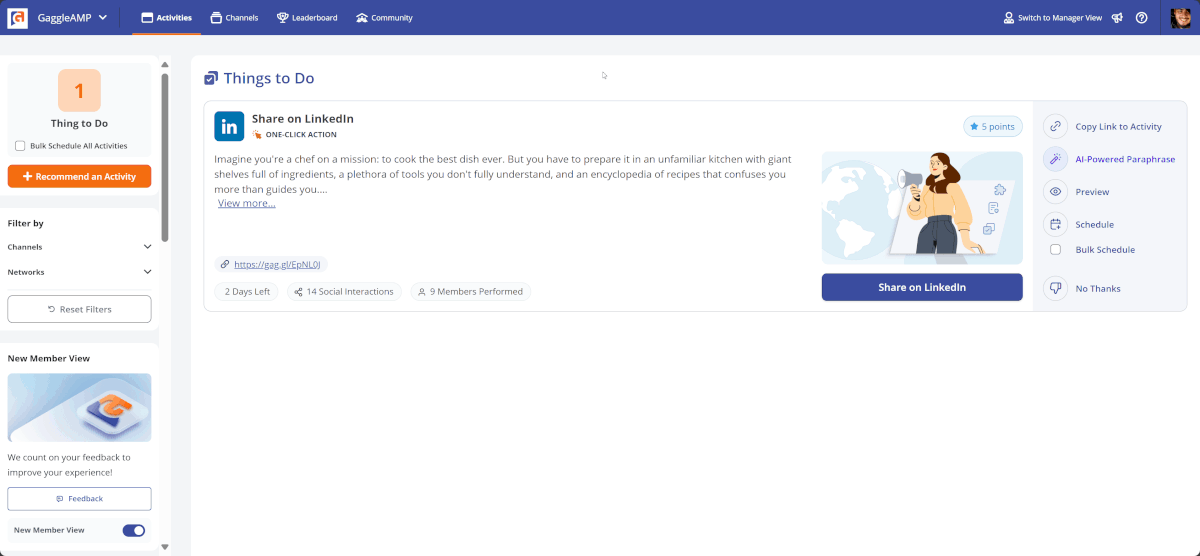
GaggleAMP is an employee advocacy platform that amplifies your content through your employees' networks.
-
Content Distribution: Encourage employees to share company content on their personal LinkedIn profiles to increase reach and visibility.
-
Engagement Tracking: Use GaggleAMP analytics to monitor the performance of your content shared by employees and identify top-performing advocates.
-
Campaign Coordination: Coordinate campaigns and provide pre-approved content for employees to share for consistent messaging and optimal impact.
Boost Your Social Selling Efforts With GaggleAMP
The LinkedIn Social Selling Index is more than just a metric; it's a roadmap for effective social selling on LinkedIn. You can significantly improve your SSI score by focusing on the four key components detailed above and leveraging the right tools and strategies. This will help grow your LinkedIn presence and drive professional growth and sales success.
Ready to take your social selling efforts to the next level? By using an employee advocacy platform like GaggleAMP, you can optimize your employee advocacy efforts on LinkedIn. Schedule a demo today!
Frequently Asked Questions
What Is the Social Selling Index?
The Social Selling Index (SSI) is a metric created by LinkedIn to measure how effectively users establish their professional brand, find the right people, engage with insights, and build relationships on the platform.
It ranges from 0 to 100, with higher scores indicating better social selling performance.
Can My SSI Score Decrease?
Yes, your SSI score can decrease if you become less active on LinkedIn, fail to engage with your network, or do not regularly update your profile and share content.
Consistency is key to maintaining and improving your score.
How Often Is the SSI Score Updated?
The SSI score is updated daily to reflect your most recent activities and engagement on LinkedIn. Check your score regularly to stay on top of your social selling efforts.
Is the SSI Score Only Relevant for Sales Professionals?
While the SSI score is particularly valuable for sales professionals, it benefits anyone looking to enhance their professional presence on LinkedIn. It helps improve personal branding, networking, and engagement on the platform.







